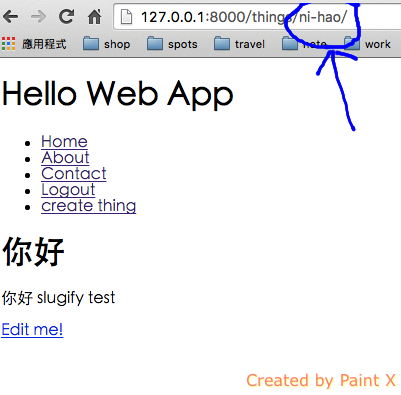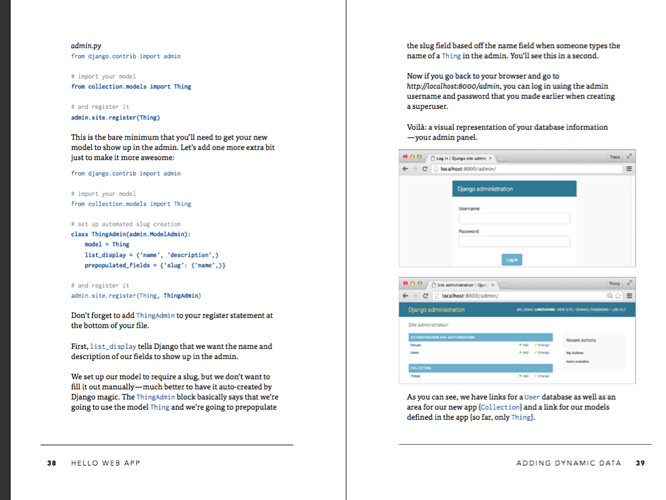in the hw app page 38,I know slug can synchronize the name in admin slug,please check the link,however,if I wanna make the name in not English,for example Chinese,how can I do it??,thank you
Django admin slug in not English
Have you tried it? Would to know whether Django’s slugify feature handles that! Chinese characters can’t be a slug… but the Django peeps are pretty smart so I wouldn’t be surprised if there was support. Also, see this page: https://docs.djangoproject.com/es/1.9/topics/i18n/
Hope this helps!
django’s slugify can handles that,just I do not know how to make it happen in admin ,for example 你好 -->ni-hao,

I can make it works on create thing in page 80 in hello web app book,I use the Django Uuslug
after I pip installed it I just “from uuslug import slugify”,it can work,however I do not know how to make it in admin,still work on this,thanks for your reply ^^ here is my code in “views.py” to create things in Chinese using uuslug ,
indent preformatted text by 4 spaces
from django.shortcuts import render,redirect
from collection.forms import ThingForm,ThingUploadForm
from collection.models import Thing,Upload
#from django.template.defaultfilters import slugify
from uuslug import slugify #make the slug can read not English
from django.contrib.auth.decorators import login_required
from django.http import Http404
def index(request):
# this is your new view
things = Thing.objects.all()
return render(request, 'index.html', {'things': things,})
def thing_detail(request, slug):
# grab the object...
thing = Thing.objects.get(slug=slug)
uploads = thing.uploads.all()
# and pass to the template
return render(request, 'things/thing_detail.html', { 'thing': thing,'uploads': uploads,})
@login_required
def edit_thing(request, slug):
# grab the object...
thing = Thing.objects.get(slug=slug)
if thing.user != request.user:
raise Http404
# set the form we're using...
form_class = ThingForm
if request.method == 'POST':
# grab the data from the submitted form
form = form_class(data=request.POST, instance=thing)
if form.is_valid():
# save the new data
form.save()
return redirect('thing_detail', slug=thing.slug)
# otherwise just create the form
else:
form = form_class(instance=thing)
# and render the template
return render(request, 'things/edit_thing.html', {
'thing': thing,
'form': form,
})
def create_thing(request):
form_class = ThingForm
# if we're coming from a submitted form, do this
if request.method == 'POST':
# grab the data from the submitted form and apply to # the form
form = form_class(request.POST)
if form.is_valid():
# create an instance but do not save yet
thing = form.save(commit=False)
# set the additional details
thing.user = request.user
thing.slug = slugify(thing.name)
# save the object
thing.save()
# redirect to our newly created thing
return redirect('thing_detail', slug=thing.slug)
# otherwise just create the form
else:
form = form_class()
return render(request, 'things/create_thing.html', { 'form': form,})
@login_required
def edit_thing_uploads(request, slug):
# grab the object...
thing = Thing.objects.get(slug=slug)
# double checking just for security
if thing.user != request.user:
raise Http404
form_class = ThingUploadForm
# if we're coming to this view from a submitted form,
if request.method == 'POST':
# grab the data from the submitted form, # note the new "files" part
form = form_class(data=request.POST,files=request.FILES, instance=thing)
if form.is_valid():
# create a new object from the submitted form
Upload.objects.create(
image=form.cleaned_data['image'],
thing=thing,
)
return redirect('edit_thing_uploads', slug=thing.slug)
# otherwise just create the form
else:
form = form_class(instance=thing)
# grab all the object's images
uploads = thing.uploads.all()
# and render the template
return render(request, 'things/edit_thing_uploads.html', {
'thing': thing,
'form': form,
'uploads': uploads,
})
@login_required
def delete_upload(request, id):
# grab the image
upload = Upload.objects.get(id=id)
# security check
if upload.thing.user != request.user:
raise Http404
# delete the image
upload.delete()
# refresh the edit page
return redirect('edit_thing_uploads', slug=upload.thing.slug)
Can you expand more on what specifically is happening now and what you’d like to happen in the admin?
like the question I asked in stackoverflow How to generate slug from Chinese text?,I need to make the slug can generate Chinese text to like speclling,你好–>ni-hao in slug admin
Cool — I think StackOverflow is the best place, I don’t think I can help you. :) Best of luck!

